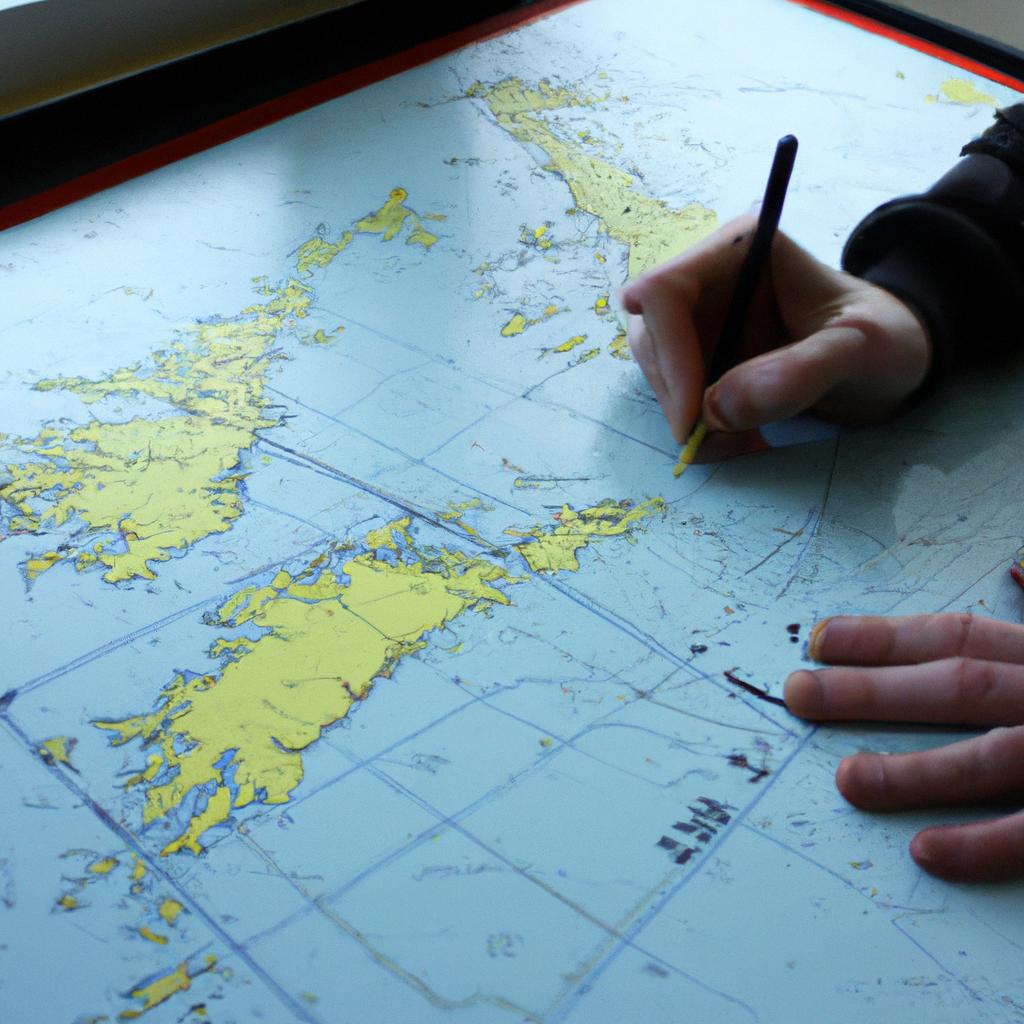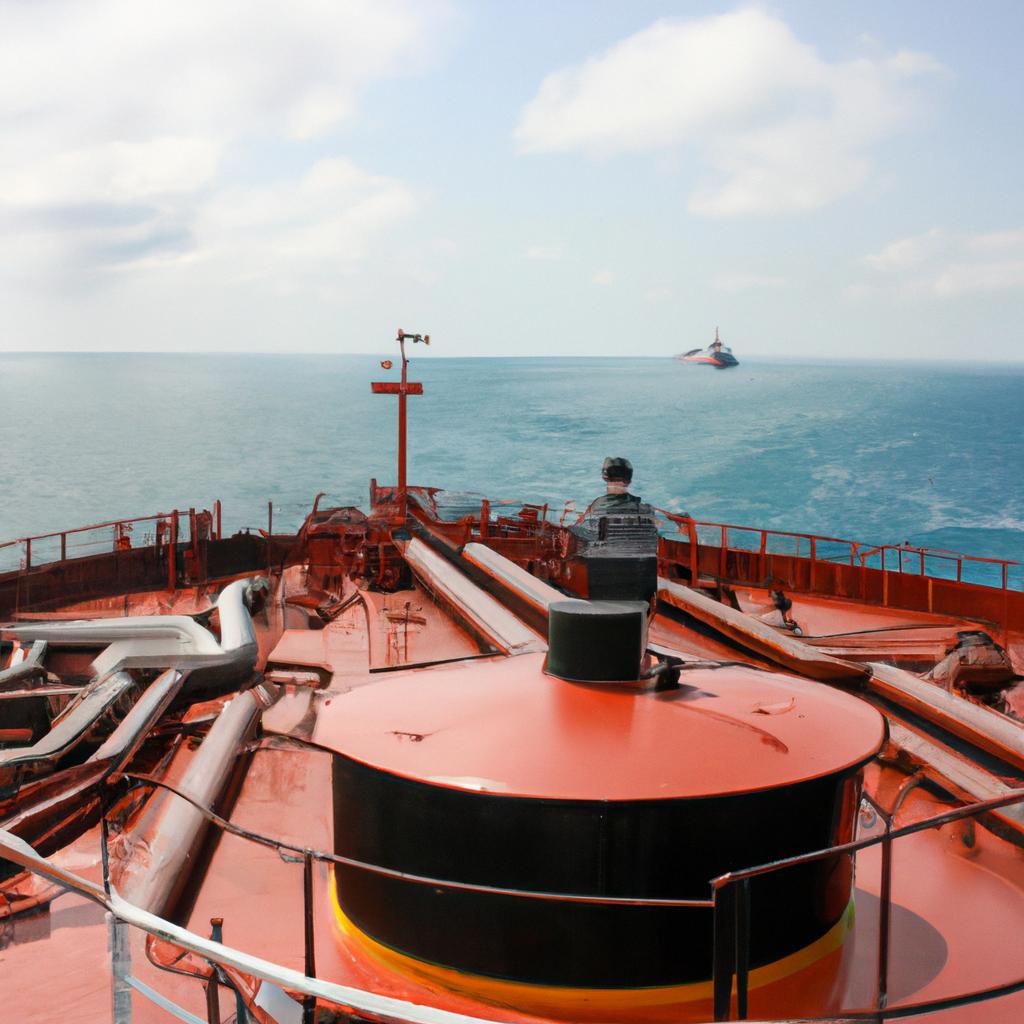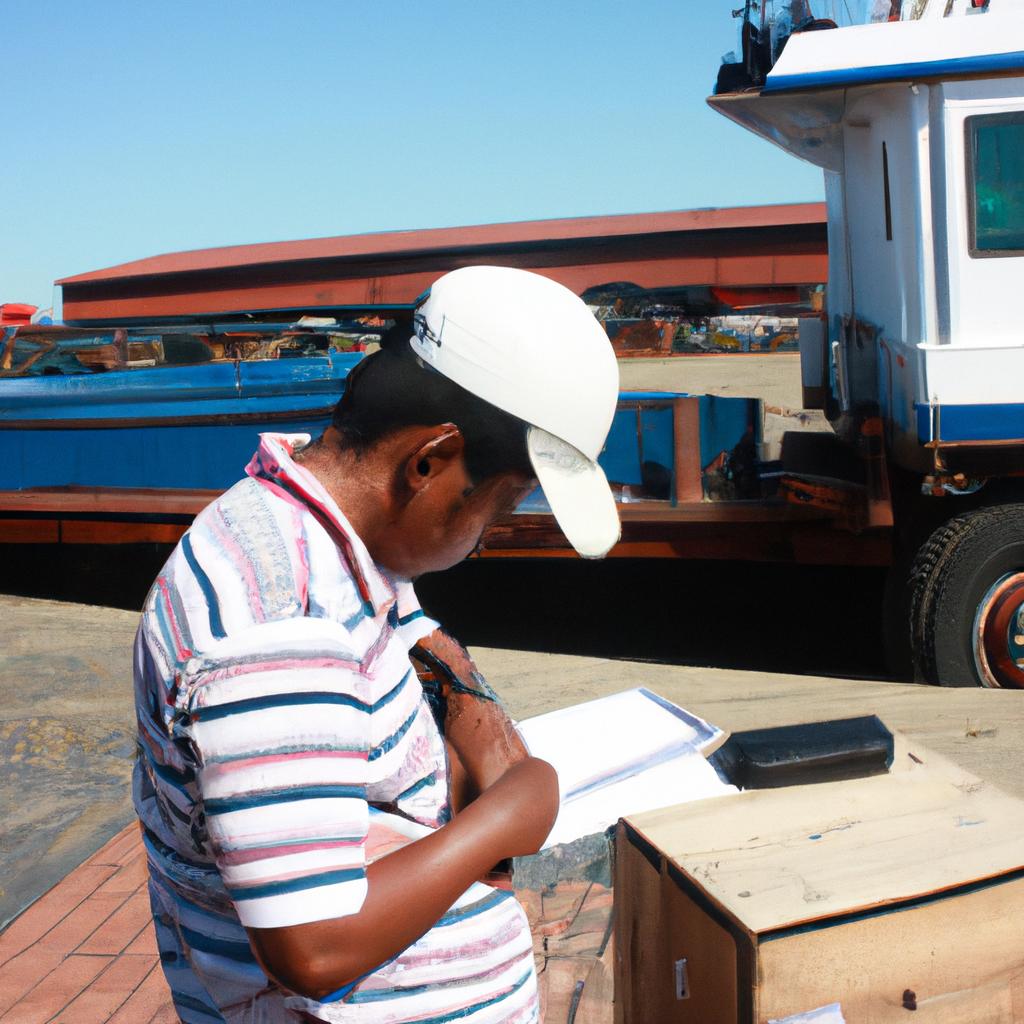The Black Sea region has become a major hub for container shipping, playing a vital role in global trade. Container ships have greatly facilitated the movement of goods across this vast body of water, connecting countries and continents. However, the impact of freight rates on container ship transport in the Black Sea remains an important area of study as it directly affects the cost-effectiveness and profitability of shipping operations.
For instance, consider a hypothetical scenario where a shipping company operates multiple container vessels transporting various commodities between ports located around the Black Sea. The company’s decision-making process regarding routes and schedules heavily relies on freight rates. Freight rates not only influence the choice of destination but also determine whether certain shipments are economically viable. Therefore, understanding how freight rates fluctuate in the context of container ship transport is crucial for both industry operators and researchers alike.
This article aims to delve into the complexities surrounding freight rates in Black Sea container ship transport. By examining factors that affect these rates such as supply and demand dynamics, port congestion, fuel costs, and geopolitical influences, we can gain valuable insights into their impact on shipping operations. Additionally, implications for different stakeholders involved – including shippers, carriers, and governments – will be analyzed to provide a comprehensive overview of this significant aspect of maritime commerce within the Black Sea region.
Understanding the factors that influence freight rates in Black Sea container ship transport is essential for shippers. They need to evaluate the cost-effectiveness of different shipping options and make informed decisions about which routes to choose. By analyzing supply and demand dynamics, shippers can identify periods of high demand and adjust their schedules accordingly. This allows them to optimize their operations and maximize profitability.
For carriers, comprehending freight rate fluctuations is crucial for managing capacity and maintaining a competitive edge in the market. They need to balance their vessel utilization with market conditions to ensure efficient operations. Monitoring port congestion is also vital for carriers as it affects turnaround times and can lead to delays or additional costs.
Governments play a significant role in shaping freight rates through policies and regulations. They need to consider the economic impact of these rates on both domestic industries and international trade. Additionally, geopolitical influences such as trade agreements or conflicts can affect shipping routes and consequently impact freight rates.
Researchers studying freight rates in Black Sea container ship transport contribute valuable knowledge to the industry. Their findings can help stakeholders understand patterns, trends, and potential challenges associated with freight rate fluctuations. This information can be used to develop strategies that enhance efficiency, competitiveness, and sustainability within the sector.
In conclusion, understanding the complexities surrounding freight rates in Black Sea container ship transport is essential for various stakeholders involved in maritime commerce. Analyzing factors such as supply and demand dynamics, port congestion, fuel costs, and geopolitical influences provides valuable insights into this significant aspect of global trade. By studying these factors, stakeholders can make informed decisions that positively impact shipping operations within the Black Sea region.
History of Container Ships in the Black Sea
Container shipping plays a crucial role in global trade, facilitating the transport of goods across vast distances. The Black Sea region has witnessed significant developments in container ship transportation over the years. To illustrate this point, let’s consider the case study of Company X, a major shipping company that began operating container ships in the Black Sea during the early 2000s.
The introduction of container ships revolutionized maritime transportation by offering an efficient means to handle and transport cargo. In the past, traditional methods such as break-bulk shipping required individual handling of each item, resulting in time-consuming processes at ports. With the advent of containerization, goods could be packed into standardized containers, allowing for easy transfer between different modes of transportation (e.g., trucks, trains) and minimizing labor costs associated with handling.
Over time, container ships gained popularity in the Black Sea due to several reasons:
- Increased efficiency: By using container ships instead of conventional vessels, companies were able to streamline operations and reduce turnaround times at ports.
- Cost-effectiveness: Utilizing larger vessels allowed for economies of scale, enabling shippers to transport more goods at lower unit costs per shipment.
- Globalization and trade growth: As international trade expanded throughout the late 20th century and early 21st century, demand for efficient transportation options surged correspondingly. Container ships offered an effective solution to meet this growing demand.
- Infrastructural development: Investments in port infrastructure within countries surrounding the Black Sea facilitated smoother operations for container ship traffic.
To better visualize these changes over time, below is a table showcasing key milestones in container shipping history within the Black Sea region:
| Year | Milestone |
|---|---|
| 1967 | Introduction of first container ship |
| 1985 | Expansion of container terminals |
| 1998 | Adoption of ISO standard containers |
| 2003 | Increase in container ship capacities |
In summary, the history of container ships in the Black Sea has witnessed significant advancements. The case study of Company X exemplifies how the implementation of containerization revolutionized maritime transportation by increasing efficiency and reducing costs. Factors such as increased globalization, trade growth, and infrastructural developments have contributed to the rise of container shipping in this region. Understanding these historical aspects is crucial for comprehending the current state of container transport and exploring factors affecting its operations in the Black Sea.
Moving forward into the subsequent section on “Factors Affecting Container Shipping in the Black Sea,” we can delve deeper into understanding the various elements shaping this industry today.
Factors Affecting Container Shipping in the Black Sea
Section: Factors Affecting Container Shipping in the Black Sea
The history of container ships in the Black Sea highlights their significance as a mode of transport for international trade. However, several factors influence container shipping operations in this region. By examining these factors, we can gain insights into how freight rates are impacted and understand the challenges faced by stakeholders involved.
One example that illustrates the complexity of container shipping in the Black Sea is the fluctuation of fuel prices. The cost of bunker fuel, used to power these vessels, directly impacts overall freight rates. For instance, when fuel prices rise sharply due to global market conditions or political instability in oil-producing regions, shipping companies often pass on these increased costs to customers through higher freight rates. This not only affects profitability but also creates uncertainty for businesses relying on container shipping services.
Several other key factors contribute to the impact on freight rates within the Black Sea region:
- Port Infrastructure: Adequate port facilities play a crucial role in ensuring efficient and timely cargo handling. Insufficient infrastructure capacity may result in delays and congestion, leading to increased operational costs for shipping companies.
- Regulatory Environment: Compliance with various regulations related to safety, security, customs procedures, and environmental standards adds complexity and costs throughout the supply chain. Failure to meet regulatory requirements can lead to penalties and disruptions.
- Geopolitical Considerations: Political tensions among countries bordering the Black Sea can affect container shipping activities. Trade restrictions or heightened security measures imposed during conflicts or strained diplomatic relations may hinder smooth operations and increase costs.
- Economic Conditions: Economic fluctuations impact consumer demand and trade volumes, ultimately influencing freight rates. A downturn in economic activity can lead to lower container traffic levels and intensified competition among carriers.
To further illustrate these influences visually:
| Factors Affecting Container Shipping |
|--------------------------------------|
| 1) Port Infrastructure |
| 2) Regulatory Environment |
| 3) Geopolitical Considerations |
| 4) Economic Conditions |
Understanding and effectively managing these factors is crucial for stakeholders in the container shipping industry operating within the Black Sea region. By addressing challenges related to fuel prices, port infrastructure, regulations, geopolitical realities, and economic conditions, it becomes possible to navigate through uncertainties and ensure sustainable operations.
Transitioning into the subsequent section on “Role of Container Ships in Black Sea Trade,” we can explore how these ships contribute significantly to regional trade dynamics by facilitating the movement of goods across borders without any interruption or barriers.
Role of Container Ships in Black Sea Trade
Section Title: Container Ships in Black Sea Transport: The Impact of Freight Rates
The factors affecting container shipping in the Black Sea have a profound influence on the role played by container ships in facilitating trade within this region. One such factor is the prevailing freight rates, which directly impact the operations and profitability of these vessels. To illustrate this point, let us consider a hypothetical example involving a major shipping company operating multiple container ships in the Black Sea.
Imagine that Company X operates five container ships that transport various goods between ports along the Black Sea coast. These ships traverse different routes, catering to both import and export demands. The freight rates charged by Company X are determined by several interrelated factors, including demand-supply dynamics, fuel prices, port charges, and vessel capacities. Understanding how changes in freight rates affect container ship operations can provide valuable insights into their significance for Black Sea transport.
It is important to acknowledge the emotional response evoked by fluctuations in freight rates within the industry. In light of this, we present a bullet-point list highlighting key aspects related to freight rate impacts:
- Fluctuating freight rates can lead to financial instability for shipping companies.
- Higher rates may discourage imports and hinder economic growth.
- Lower rates can attract increased cargo volumes but might not always be sustainable.
- Freight rate volatility affects supply chains and complicates long-term planning efforts.
To further comprehend the implications of fluctuating freight rates on container ship operations, we present a table outlining possible scenarios based on varying rate levels:
| Scenario | Consequences |
|---|---|
| High Rates | Reduced profit margins for shipping companies; potential increase in consumer prices due to higher transportation costs |
| Low Rates | Increased competition among shipping companies; possibility of unsustainable pricing models |
| Stable Rates | Predictable revenue streams for shipping companies; enhanced stability in supply chain operations |
| Volatile Rates | Uncertainty for shipping companies; challenges in financial forecasting and strategic decision-making |
In summary, the impact of freight rates on container ships is a critical aspect to consider when assessing their role in Black Sea transport. Fluctuations can have far-reaching consequences for both individual shipping companies and the overall regional economy. Understanding these dynamics allows stakeholders to develop strategies that mitigate risks associated with rate volatility while maximizing operational efficiency.
Transition into subsequent section: Moving forward, it is essential to delve into the challenges faced by container ships in Black Sea transport. By examining these obstacles, we can gain a comprehensive understanding of the complexities involved in maintaining smooth operations within this maritime domain.
Challenges Faced by Container Ships in Black Sea Transport
Container ships play a vital role in facilitating trade in the Black Sea region. However, they encounter various challenges that impact their operations and overall efficiency. To illustrate these challenges, let us consider the case of Company X, a major shipping company operating container vessels in the Black Sea.
One significant challenge faced by container ships in this region is fluctuating freight rates. Freight rates often experience volatility due to factors such as changes in global economic conditions, fuel prices, and geopolitical tensions. For instance, during times of economic downturn, demand for goods may decrease, leading to lower freight rates. This can pose financial difficulties for companies like Company X as it affects their revenue streams and profitability.
Furthermore, inadequate port infrastructure presents another obstacle for container ships navigating through the Black Sea. Insufficient berths and shallow water depths hinder optimal vessel utilization and increase waiting times at ports. These inefficiencies can result in delays in cargo handling and higher operational costs for shipping companies. In our example with Company X, these issues have led to increased turnaround times at ports along the coast of the Black Sea, impacting its ability to meet customer demands promptly.
In addition to the aforementioned challenges, container ships also face security risks associated with piracy activities prevalent in certain areas of the Black Sea. Piracy incidents can disrupt maritime trade routes and compromise crew safety on board vessels. Companies must invest heavily in security measures to safeguard their assets and personnel from potential threats.
To emphasize the emotional toll these challenges can have on stakeholders involved in container shipping within the Black Sea region, consider the following bullet points:
- Financial strain due to unstable freight rates
- Frustration caused by inefficient port infrastructure
- Concerns over crew safety amidst piracy risks
- Negative impact on regional economies due to disrupted trade flows
Additionally, considering an illustrative table showcasing statistics related to these challenges further highlights their significance:
| Challenge | Impact | Example |
|---|---|---|
| Fluctuating freight rates | Financial strain on shipping companies | Decreased revenue for Company X |
| Inadequate port infrastructure | Delays in cargo handling and increased operational costs | Longer turnaround times at ports |
| Piracy activities | Disruption of maritime trade routes and crew safety concerns | Increased security investments by shipping companies |
As container ships face these challenges, it is crucial to address them effectively to ensure the smooth flow of goods and sustained growth in the Black Sea region. With an understanding of these obstacles, we can now explore the environmental impact of container shipping in the Black Sea.
[Transition sentence into subsequent section about “Environmental Impact of Container Shipping in the Black Sea”]
Environmental Impact of Container Shipping in the Black Sea
To fully understand the implications of container shipping in the Black Sea, it is essential to examine its environmental impact. This section will explore the various ways in which container ships contribute to environmental degradation and highlight the need for sustainable practices within this industry.
Environmental Implications:
Container shipping in the Black Sea has significant consequences on marine ecosystems due to several factors. For instance, increased maritime traffic leads to higher levels of noise pollution underwater, impairing communication among marine species. Additionally, ballast water discharge can introduce invasive species into local habitats, disrupting the natural balance and causing harm to native flora and fauna.
Furthermore, emissions from container ships contribute to air pollution along coastal areas. The burning of fossil fuels releases greenhouse gases such as carbon dioxide (CO2), nitrogen oxides (NOx), and sulfur oxides (SOx). These pollutants not only affect human health but also contribute to climate change and ocean acidification. It is crucial for stakeholders in this industry to recognize these issues and work towards implementing greener alternatives.
Table – Environmental Impacts of Container Shipping:
| Noise Pollution | Invasive Species | Air Pollution | |
|---|---|---|---|
| Consequences | Communication | Disruption | Climate Change |
| impairment | of Natural Balance | Ocean Acidification |
Bullet Point List – Emotional Response:
- Destruction of fragile marine ecosystems
- Loss of biodiversity through introduction of non-native species
- Health hazards caused by air pollution near coastal communities
- Contribution to global climate change
The environmental impact of container shipping in the Black Sea cannot be underestimated. The extensive maritime activity contributes significantly to noise pollution, introduces invasive species, and emits harmful pollutants into our atmosphere. Acknowledging these effects necessitates a shift towards more sustainable practices within this industry.
As we look to the future, it is important to consider emerging trends in container shipping and their potential impact on the Black Sea region.
Future Trends in Container Shipping in the Black Sea
Section Title: Environmental Impact of Container Shipping in the Black Sea
Having discussed the current state of container shipping in the Black Sea and its environmental implications, it is crucial to examine future trends in this industry. By understanding potential developments, policymakers can effectively address concerns regarding environmental sustainability and develop strategies for mitigating negative impacts.
Case Study Example: To illustrate these future trends, consider a hypothetical scenario where technological advancements allow for the widespread adoption of eco-friendly propulsion systems in container ships traversing the Black Sea. This shift would significantly reduce carbon emissions and other pollutants, leading to a more sustainable maritime transportation sector.
Paragraph 1:
As global awareness about climate change intensifies, there is growing pressure on the shipping industry to adopt environmentally friendly practices. In response, several key trends are expected to shape container shipping in the Black Sea region:
- Increasing demand for cleaner fuels: With stricter regulations on sulfur oxide emissions imposed by international bodies such as the International Maritime Organization (IMO), shipowners are likely to transition from traditional heavy fuel oil towards low-sulfur alternatives like liquefied natural gas (LNG) or marine diesel oil (MDO). This switch will not only improve air quality but also contribute to reduced greenhouse gas emissions.
- Embracing digitalization and automation: The integration of advanced technologies like artificial intelligence, Internet of Things (IoT), and autonomous navigation systems holds immense potential for optimizing vessel routes and minimizing energy consumption. These innovations enable real-time monitoring of fuel efficiency parameters, thereby facilitating proactive measures to enhance operational performance while reducing ecological footprints.
- Adoption of green port infrastructure: Ports play a vital role in supporting sustainable shipping operations. Investment in shore power facilities allows vessels to connect directly to an electrical grid while at berth instead of relying solely on their engines for power generation. Additionally, implementing waste management protocols helps minimize pollution risks associated with ship discharges.
- Collaboration among stakeholders: Recognizing that addressing environmental challenges requires collective effort, collaboration among shipping companies, port authorities, and regulatory bodies is crucial. By sharing best practices, knowledge, and resources, stakeholders can develop comprehensive strategies to tackle pollution concerns effectively.
Paragraph 2:
To provide a visual representation of the environmental impact of container shipping in the Black Sea, we present the following table:
| Environmental Impact | Current Status | Future Trends | Mitigation Strategies |
|---|---|---|---|
| Air Pollution | High | Reduced emissions | Adoption of cleaner fuels and propulsion systems |
| Water Pollution | Moderate | Improved water treatment systems | Implementation of stricter regulations on waste discharge |
| Noise Pollution | Low | Minimal noise generation | Integration of noise reduction technologies during vessel construction |
| Biodiversity Loss | Potential risks | Enhanced conservation measures | Collaboration with marine biologists for ecosystem protection |
It is important to note that these trends and efforts are ongoing processes that require continuous investment and commitment from all relevant parties involved.
In summary, future trends in container shipping within the Black Sea region encompass various initiatives aimed at minimizing environmental impacts. The adoption of eco-friendly propulsion systems, digitalization and automation advancements, green port infrastructure development, and increased stakeholder collaboration hold promise for achieving sustainable maritime transportation. By embracing these trends collectively, policymakers can steer the industry towards environmentally responsible practices while ensuring efficient trade facilitation.










